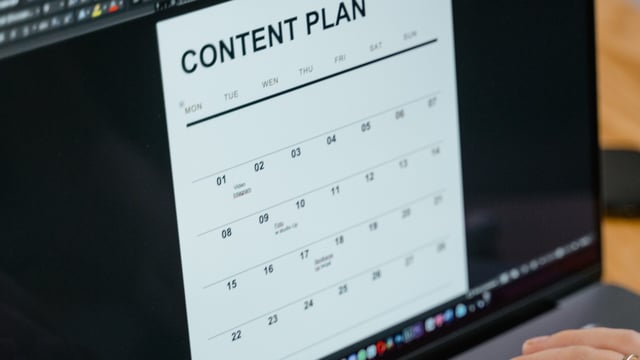
How To Avoid Overwhelm When Planning Out Your Content

Content creation is a piece of marketing that you cannot avoid. Businesses need to have a digital presence to attract and connect with their audience, but that’s not to say it’s easy.
Entrepreneurs and marketing managers alike find content creation overwhelming and stressful. However, you can mitigate much of that stress by putting together a content plan. Whether you have a team to help or you’re doing it all on your own – content planning comes down to strategy and knowing your audience. Businesses with a content plan in place are more likely to create value-driven content for their audience.
It’s much easier to start the month or quarter with a plan than constantly thinking of new ways to engage your audience.
But any marketer will tell you that even with a plan, it’s completely normal to feel like you’re drowning. Scheduling out blogs, social media, newsletters, engagement, etc. – it’s a LOT! And can sometimes be too much. How are we supposed to plan and create content with this unshakable stress? It’s draining, but it doesn’t have to be.
In this blog, we’ll discuss why businesses need to plan content, why it’s overwhelming for so many marketers and entrepreneurs, and expand on three ways to prevent overwhelm when tackling a content plan.
Table of Contents
- Why It’s Important to Plan Content & Why It Can Get Overwhelming
- 3 Ways to Prevent Overwhelm
- Being Overwhelmed is Inevitable
- Get in Touch
Why you Need a Content Plan & Why it’s Overwhelming
Business owners know marketing is essential to building brand awareness and connecting with their audience. The term “marketing” is broad, but it includes paid ads and organic SEO practices (social media, blogging, etc.). However you choose to market your business, whether through paid ads, organically, or both, entrepreneurs take on a heavy mental and physical load and need to create a lot of content.
Marketers need to:
- Think of topics that are helpful and resonate with your audience.
- Create imagery – this could mean having photoshoots, hiring a graphic designer, or doing it yourself
- Write content – this could be blog content, ad copy, social media captions, email copy, etc.
- Share it and engage with your audience. You can share it through paid advertising or organic advertising.
So, when business owners think about all they need to do, there’s no surprise that they become overwhelmed and don’t know how to move forward. I mean, where do you even start?!
Planning out content a week, a month, or a quarter ahead is overwhelming for anyone, especially as you start to see how each marketing initiative can connect or should connect. Once you let those feelings get the better of you, it’s hard to start, but it doesn’t have to be like that. There are ways to tackle a content plan, step by step, to avoid overwhelm.
3 Ways to Prevent Overwhelm
Research & Define Your Audience
The first step to avoiding overwhelm when planning out your content is doing your research and knowing your audience.
While the idea of research can be exhausting, it’s easy to do once you know where to start.
Here are past blogs we’ve written on understanding your audience better:
- Marketing Hack – Three Ways to Research Your Ideal Audience and What You Should Be Looking For
- Do You Really Know Your Audience, or Are you Just Guessing?
While researching, look for things like trends and unanswered questions from your community. Through it all, stay in touch with your marketing goals. This does not have to be a deep dive into your research – you can start from a high level and ask yourself questions like:
- What is content marketing?
- What type of content does my audience interact with?
- How will this help my business?
Once you’re able to outline your audience, specific buyer personas, and business goals, it’s much easier to move forward and make intentional and educated marketing decisions like – what to post, what platforms to use, how to speak, etc.

How Does This Help Avoid Becoming Overwhelmed?
Researching and defining your audience helps center your thoughts as you create a content plan. There are infinite personalities and audience types in this world, but narrowing it down and defining your audience, what they’re interested in, the content they like to consume, etc. helps you focus your thoughts and make educated content decisions. You want to identify your audience, your business personality, and what platforms make sense so that your business can show up in its most authentic self.
Define Your Pillars
With the information you’ve learned about your brand, preferred content, and audience – it’s time to start defining your pillars. Your content pillars are topics you want to talk about consistently. For example, if you’re a landscaping company, you don’t want to talk about the news (unless it has to do with landscaping).
Another example would be a cleaning company. The content pillars for a cleaning company may look like this:
- Customer Specials
- Easy Cleaning Hacks
- Testimonials
Outlining your content pillars allows businesses to look at a week, a month, or a quarter and know what they need to post. So in this cleaning company example, this business knows they need to share a cleaning special, a hack, and a testimonial once a week.
When researching your audience, you learn where they’re spending their time, so look to those platforms when creating a plan. Then, with those platforms in mind, look at the optimal days to post. Remember, the goal of content is not only to build brand awareness but also to drive traffic to your website, right? That means you’ll need to create written or website content and reference it in your advertising or social posts to encourage people to go to your website.
To summarize – your pillars should help you focus on the type of content you intend to share. From there, you can pinpoint the days you want to post, what you want to post (a video, blog, graphic, etc.), and what you want to say. However, by dedicating those pillars to specific days of the week, you can plan ahead and prepare.
For example, you can share cleaning specials on Mondays, cleaning hacks on Wednesdays, and testimonials on Friday. Knowing your business’s cadence allows you the peace of mind to look ahead and feel prepared.
How Does This Help Avoid Becoming Overwhelmed?
Defining your pillars is another way to center your business and your content. There are so many potential things to speak about and platforms to show up on – which is the problem. You cannot do it all, so hone in on what’s important. Once you know your audience, you can narrow down where you show up. For example, if you’re targeting a younger crowd – TikTok may be for you, but if you’re looking to target a more professional group, you may want to focus on optimizing your time on LinkedIn.

Make Repurposable Content
Next, as you learn more about your pillars and the places you want to show up, find ways that you can repurpose your content. Every piece of content you create involves work, and if done right, you can use one piece of content and turn it into 3 -5 different small pieces.
For example, if you create blog content, you can then take pieces of that blog post and reformat it for social media. The benefit is that you’re not duplicating any effort. The content is there; now you just need to focus it. Repurposing content allows marketers to work more efficiently, streamline their work, and create content that connects.
Another way to repurpose content is to look at your old work and see what performed well. Pick out a few pieces that performed well for your audience and repurpose them to fit today’s needs.
This could be:
- Taking YouTube videos and creating shorter content pieces for TikTok or Reels
- Taking a long-form video and turning it into a podcast
- Looking at an older blog and updating it, so it’s relevant to your audience today.
When it comes to content creation and planning – look towards using your time efficiently. For example, rather than planning three social posts that vary in topics, create one blog post, pinpoint three important pieces from that blog, and use it for social! This way, your social media content relates to your blog content, and you can always direct your social media audience to your blog for more information.
How Does This Help Avoid Becoming Overwhelmed?
Creating authentic content is the first step, but being intentional about the content you’re creating is what’s going to help you avoid being overwhelmed. By creating long-form content that’s targeted and speaking to your audience, you can use what you create and break it down so it’s relevant to other platforms. For example, if you write a blog full of important information, you can break that blog post up and reuse it for your social media, newsletters, emails, etc.
Being Overwhelmed is Inevitable
Being overwhelmed, especially when it comes to content planning, is inevitable. As marketers and entrepreneurs, we look at the big picture and how everything connects. So when planning, we’re forced to break it all down. We must take those big ideas in our heads and make them manageable and shareable for our audience.
Additionally, there’s this unspoken pressure of wanting to do it all. We want to show up and connect with our audience anywhere and everywhere. We want to continuously build brand awareness on every platform that’s available to us, but it’s not sustainable – especially if it’s just you or a small team.
By breaking things down and focusing on:
- Creating intentional content
- Knowing your audience and your brand
- Knowing where you need to show up versus where you want to show up
- How to repurpose content
You can then tackle a content plan and be intentional about what you want to do and where you want to do it.
Being intentional and consistent on specific platforms allows your business to really make an impact.
As you get more comfortable with platforms you know are essential to your business, you can then grow that business’s voice, turn your audience into leads, and finally turn your leads into customers. As you increase your budget, you can start looking at adding more content to your content plan.
Remember to take it all step by step – you’re helping no one by doing too much, and the best way to create long-lasting content is to be consistent with it. So grab a calendar and be intentional with your thoughts and what you want to post. Keep your goals and pillars in mind as you start filling out your month. First, focus on the days you want to post, then what you want to post, where you want to post, and finally, create the content in full.
Creating a detailed content calendar helps marketers move through the days, weeks, and months with little to no guesswork (at least where content is concerned). Make sure you also plan content creation days. It’s challenging to switch hats and multitask, but if you’re focusing on content for a full day, it’s more likely that you can focus and finish it with your goals and audience in mind.
A well-designed content calendar provides a set of guidelines that marketers can follow, but a lot of it starts with filtering out what you want to do versus what you need to do and where you need to show up.
Get in Touch
If you’re ready to create a content plan or you’ve started, and you’re running into anxiety and overwhelm – join the conversation on LinkedIn. Let’s discuss all things marketing, content creation, and why businesses need to share thoughtful and authentic content.
If you’re ready to dive right in and get started, schedule a discovery call so we can discuss your business’s needs, goals, and any challenges. We’d love to partner with you!


